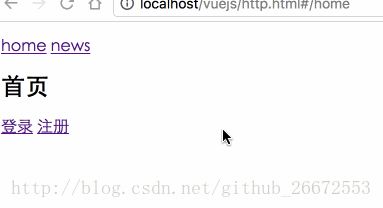vue-router:嵌套路由的使用方法
模板抽离
我们已经学习过了Vue模板的另外定义形式,使用<template></template>。
<!-- 模板抽离出来 -->
<template id="home">
<div>首页</div>
</template>
<template id="news">
<div>新闻</div>
</template>
然后js里定义路由组件的时候:
// 1. 定义(路由)组件。
const Home = { template: '#home' };
const News = { template: '#news' };
路由嵌套
实际应用界面,通常由多层嵌套的组件组合而成。
比如,我们 “首页”组件中,还嵌套着 “登录”和 “注册”组件,那么URL对应就是/home/login和/home/reg。
<template id="home">
<!-- 注意:组件只能有一个根元素,所以我们包装到这个div中 -->
<div>
<h2>首页</h2>
<router-link to="/home/login">登录</router-link>
<router-link to="/home/reg">注册</router-link>
<!-- 路由匹配到的组件将渲染在这里 -->
<router-view></router-view>
</div>
</template>
这是访问/home后的模板,其中我们需要把/home/login和/home/reg渲染进来。
完成上面代码后,HTML结构如下图:

登录和注册2个组件
<template id="login">
<div>登录界面</div>
</template>
<template id="reg">
<div>注册界面</div>
</template>
//定义路由组件
const Login = { template: '#login' };
const Reg = { template: '#reg' };
3.定义路由
// 2. 定义路由
const routes = [
{ path: '/', redirect: '/home' },
{
path: '/home',
component: Home,
children:[
{ path: '/home/login', component: Login},
{ path: '/home/reg', component: Reg}
]
},
{ path: '/news', component: News}
]
注意我们在home路由配置了它的children。这就是嵌套路由。
4.案例全部代码如下:
<!DOCTYPE html>
<html>
<head>
<title></title>
<meta charset="utf-8">
<script src="http://unpkg.com/vue/dist/vue.js"></script>
<script src="https://unpkg.com/vue-router/dist/vue-router.js"></script>
</head>
<body>
<div id="box">
<p>
<router-link to="/home">home</router-link>
<router-link to="/news">news</router-link>
</p>
<router-view></router-view>
</div>
<!-- 模板抽离出来 -->
<template id="home">
<!-- 注意:组件只能有一个根元素,所以我们包装到这个div中 -->
<div>
<h2>首页</h2>
<router-link to="/home/login">登录</router-link>
<router-link to="/home/reg">注册</router-link>
<!-- 路由匹配到的组件将渲染在这里 -->
<router-view></router-view>
</div>
</template>
<template id="news">
<div>新闻</div>
</template>
<template id="login">
<div>登录界面</div>
</template>
<template id="reg">
<div>注册界面</div>
</template>
<script type="text/javascript">
// 1. 定义(路由)组件。
const Home = { template: '#home' };
const News = { template: '#news' };
const Login = { template: '#login' };
const Reg = { template: '#reg' };
// 2. 定义路由
const routes = [
{ path: '/', redirect: '/home' },
{
path: '/home',
component: Home,
children:[
{ path: '/home/login', component: Login},
{ path: '/home/reg', component: Reg}
]
},
{ path: '/news', component: News}
]
// 3. 创建 router 实例,然后传 `routes` 配置
const router = new VueRouter({
routes // (缩写)相当于 routes: routes
})
// 4. 创建和挂载根实例。
// 记得要通过 router 配置参数注入路由,
// 从而让整个应用都有路由功能
const app = new Vue({
router
}).$mount('#box')
// 现在,应用已经启动了!
</script>
</body>
</html>

以上就是本文的全部内容,希望对大家的学习有所帮助,也希望大家多多支持小牛知识库。
-
本文向大家介绍vue-router实现嵌套路由的讲解,包括了vue-router实现嵌套路由的讲解的使用技巧和注意事项,需要的朋友参考一下 一、嵌套路由(配置好父路由component后,在父路由下面添加children属性来配置这个父路由的子路由) 需要注意的是:父组件中的<router-view></router-view>是子组件的占位符是必不可少的 嵌套路由的现象:点击了路由跳转之后父路由
-
问题内容: 我目前正在使用React Router v4来嵌套路由。 最接近的示例是React-Router v4文档中的route配置 。 我想将我的应用分为2个不同的部分。 前端和管理区域。 我在想这样的事情: 前端的布局和样式与管理区域不同。因此,在首页中,回家的路线大约应该是子路线。 / home 应该呈现在Frontpage组件中, / admin / home 应该呈现在Backend
-
问题内容: 我正在React-Router中设置一些嵌套路由(我正在使用v0.11.6),但是每当我尝试访问其中一个嵌套路由时,都会触发父路由。 我的路线如下所示: 如果我将路线折叠起来,它看起来像: 它工作正常。之所以要嵌套,是因为我将在“仪表盘”下有多个子代,并希望它们在URL中都带有前缀。 问题答案: 配置与路由无关(尽管有名称),而是与路径驱动的布局有关。 因此,使用此配置: 就是说要嵌入
-
本文向大家介绍讲解vue-router之什么是嵌套路由,包括了讲解vue-router之什么是嵌套路由的使用技巧和注意事项,需要的朋友参考一下 上一次给大家简单说了下什么是动态路由现在我们来讲讲嵌套路由。 GitHub:https://github.com/Ewall1106/mall 1.嵌套路由的使用场景是什么呢? 大家都知道选项卡,在选项卡中,顶部有数个导航栏,中间的主体显示的是内容;这个时
-
关于vue-router的嵌套路由和编程式导航的问题 在向子路由的导航中,我发现router.push方法会将本级路由修改而不是导向子路由 router.push('mainPageView') 在当前路由为'/MainPage'的情况下,会将路由信息更改为'/mainPageView',而不是期望的'/MainPage/mianPageView',导致 我试着使用完全地址 发现能够正常使用。但在
-
本文向大家介绍解决vue-router 嵌套路由没反应的问题,包括了解决vue-router 嵌套路由没反应的问题的使用技巧和注意事项,需要的朋友参考一下 先看下route.js 当你访问的时候,发现 http://localhost:8080/#/login http://localhost:8080/#/class 都正常,但是: http://localhost:8080/#/course/

